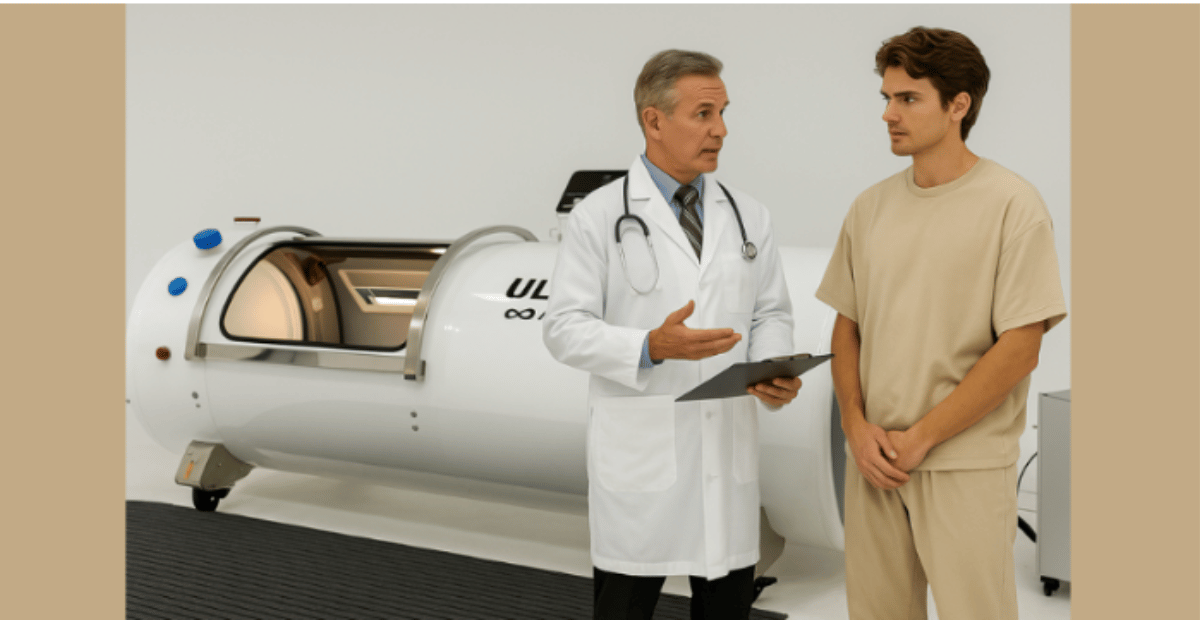Hyperbaric oxygen therapy (HBOT) offers significant benefits for healing and recovery, but it’s not suitable for everyone. People with certain medical conditions, medications, or risk factors may not be good candidates for HBOT. Understanding these contraindications ensures treatment safety and effectiveness.
If you’re considering this therapy, it’s vital to consult a qualified healthcare provider who can determine whether HBOT suits your specific health needs. A professional evaluation ensures your sessions are safe, effective, and personalized, helping you experience the potential wellness benefits of oxygen therapy while minimizing any possible risks or complications.

Understanding Hyperbaric Oxygen Therapy
Hyperbaric oxygen therapy involves breathing pure oxygen inside a pressurized chamber. This increased pressure helps the lungs absorb more oxygen, improving circulation and accelerating the body’s healing process. HBOT is commonly used to treat conditions such as non-healing wounds, carbon monoxide poisoning, and decompression sickness.
While HBOT is generally safe, not everyone can undergo this treatment. Let’s look at who should avoid hyperbaric oxygen therapy and why.
Explore our range of hyperbaric chambers for sale to learn how these devices support safe and effective oxygen therapy.
Medical Conditions That Exclude Candidates for HBOT
Certain health conditions may increase risks during hyperbaric treatment. Here are some cases where HBOT is not recommended:
|
Condition |
Why It’s a Concern |
|
Untreated Pneumothorax |
The pressure in the chamber can cause lung collapse or worsen existing damage. |
|
Severe COPD or Emphysema |
Air trapping in the lungs can lead to barotrauma under high pressure. |
|
Recent Ear Surgery or Severe Sinus Problems |
Pressure changes can cause pain, bleeding, or ear damage. |
|
Fever or Respiratory Infection |
Can increase risk of seizure or discomfort due to pressure sensitivity. |
|
Claustrophobia |
The enclosed space may cause panic or anxiety. |
|
Seizure Disorders |
High oxygen concentration may trigger oxygen toxicity seizures. |
|
Pregnancy |
HBOT is avoided unless absolutely necessary, as effects on the fetus are not fully known. |
Individuals with these conditions should not start HBOT without a comprehensive medical evaluation.
For more insights, check our guide to hyperbaric chamber treatments in Orlando and learn about safe usage options.

Medications That May Interact Negatively with HBOT
Certain medications can interfere with oxygen therapy or increase the risk of side effects. Your healthcare provider must review your current prescriptions before starting treatment.
|
Medication Type |
Potential Risk During HBOT |
|
Doxorubicin (chemotherapy) |
Can cause heart damage when combined with high oxygen levels. |
|
Bleomycin |
Increases lung toxicity risk under oxygen-rich conditions. |
|
Disulfiram (used for alcohol dependence) |
May heighten oxygen toxicity and nervous system effects. |
|
Cisplatin |
Can reduce the healing benefits of HBOT on tissues. |
Always disclose your full medical and medication history before therapy to ensure safety and maximum benefit.
For those seeking specialized care, see our Fort Worth hyperbaric chamber options to find a treatment center near you.
Temporary Contraindications
Some conditions do not permanently disqualify you but must be carefully stabilized before beginning HBOT. These include temporary health concerns that could affect pressure tolerance or oxygen absorption. Proper medical evaluation ensures your treatment remains safe, effective, and aligned with your overall wellness goals before proceeding with hyperbaric oxygen therapy.
-
Upper respiratory infections that affect sinus or ear pressure regulation.
-
Recent ear barotrauma that needs recovery before pressure exposure.
-
High fever, which may increase the risk of oxygen-induced seizures.
-
Recent thoracic surgery, where pressure changes could interfere with healing.
Once these issues are resolved, most patients can safely resume or begin HBOT under supervision.

Risk Factors to Discuss with Your Doctor
Even if you don’t have a direct contraindication, certain factors require extra caution:
-
Heart disease or pacemakers – While HBOT generally supports cardiovascular health, monitoring is essential.
-
Diabetes – HBOT can affect blood sugar levels; blood glucose should be closely managed.
-
Ear and sinus sensitivity – Equalizing pressure might be painful for some users.
-
Anxiety or panic disorders – Psychological readiness is key to ensure comfort in the chamber.
If you have concerns about whether HBOT is right for you, it’s best to consult a licensed medical professional experienced in hyperbaric protocols. They can assess your health history, explain potential benefits and risks, and determine whether this therapy aligns safely with your specific wellness or recovery goals.
Why Certain People Are Not Candidates
The main reason some individuals are not candidates for hyperbaric oxygen therapy is the risk of oxygen toxicity, barotrauma, or cardiovascular strain. These complications may arise when high oxygen pressure interacts with preexisting health conditions.
The therapy’s goal is to improve tissue oxygenation, but in some cases, increased oxygen levels may worsen underlying issues. Understanding these limitations ensures that only those who can safely benefit undergo treatment.
If you’re exploring locations for safe therapy, visit our Miami hyperbaric chamber collection to find trusted options.

Safety Guidelines for Potential Candidates
Before starting HBOT, candidates must complete:
-
Medical screening – Evaluates respiratory, cardiac, and neurological history.
-
Ear and sinus examination – Ensures you can tolerate pressure changes.
-
Blood glucose testing – Particularly for diabetic patients.
-
Medication review – Checks for potential drug interactions.
Patients who pass these assessments can safely benefit from therapy with minimal side effects.
For a deeper understanding of how HBOT benefits differ by region, explore our related articles:
Key Takeaways: Who Is Not a Candidate for HBOT?
|
Not a Candidate If You Have |
Reason |
|
Untreated pneumothorax |
Can lead to lung injury or collapse. |
|
Certain chemotherapy drugs |
May cause toxic reactions with oxygen. |
|
Recent ear or sinus surgery |
Pressure changes can harm recovery. |
|
Severe anxiety or claustrophobia |
Can lead to panic in the chamber. |
|
Pregnancy (without emergency need) |
Potential fetal risks not fully studied. |
If any of these apply to you, discuss alternatives with your healthcare provider before considering HBOT.
Additional Insights: Making an Informed Decision
Hyperbaric oxygen therapy can dramatically improve healing in approved conditions like diabetic ulcers, carbon monoxide poisoning, and radiation injuries. However, knowing who should avoid HBOT is equally important. It helps prevent complications and ensures the therapy remains a safe, life-enhancing option for those who truly benefit from it.
Final Thoughts: Who Is Not a Candidate for Hyperbaric Oxygen Therapy?
Understanding who is not a candidate for hyperbaric oxygen therapy helps ensure patient safety and improve treatment outcomes. While HBOT can offer therapeutic benefits for many conditions, it’s not suitable for everyone.
Individuals with untreated pneumothorax (collapsed lung), certain lung diseases like severe COPD, or uncontrolled seizure disorders are generally not candidates for hyperbaric oxygen therapy due to the increased risk of complications under high-pressure oxygen environments. Likewise, people with ear or sinus problems, upper respiratory infections, or fevers may experience discomfort or injury during treatment sessions.
Patients with unstable heart conditions, recent surgeries involving air-filled spaces, or implants that are not pressure-compatible should also consult their healthcare provider before considering HBOT. In some cases, pregnant individuals and those undergoing chemotherapy or radiation therapy may require special medical clearance before treatment.
To determine if HBOT is right for you, always consult a certified hyperbaric oxygen therapy specialist. They can evaluate your medical history, discuss potential risks, and guide you toward the safest treatment approach.
Hyperbaric oxygen therapy can be a powerful tool for healing and recovery when used appropriately, but only when it’s matched with the right candidate and professional oversight.
If you’re exploring HBOT options or want to learn more about how it can fit into your wellness or recovery plan, explore our collections below:
FAQs: Who Is Not a Candidate for Hyperbaric Oxygen Therapy?
Who is a good candidate for hyperbaric oxygen therapy?
A good candidate for HBOT is someone with medically approved conditions such as non-healing wounds, infections, or carbon monoxide poisoning. Individuals should be free of contraindications like lung collapse or certain chemotherapy treatments. Consultation with a hyperbaric specialist ensures proper evaluation and personalized treatment planning.
What are the disadvantages of hyperbaric oxygen treatment?
While HBOT offers many benefits, potential drawbacks include ear pressure discomfort, temporary vision changes, and, rarely, oxygen toxicity. Some patients experience mild fatigue or sinus pressure post-treatment. Following medical supervision and gradual exposure reduces these risks significantly.
What is the most common complication of hyperbaric oxygen therapy?
The most common complication is barotrauma, caused by pressure changes affecting the middle ear or sinuses. Symptoms may include pain, fullness, or minor bleeding. Proper ear equalization techniques and monitoring help prevent this issue during HBOT sessions.
What is the miracle of hyperbaric oxygen therapy?
The “miracle” of HBOT lies in its ability to stimulate tissue regeneration and accelerate healing. By delivering oxygen directly to damaged areas, it promotes faster recovery from chronic wounds, infections, and post-surgical inflammation. This effect is particularly helpful for patients with limited blood circulation or diabetic complications.
What are early signs of oxygen toxicity?
Early signs of oxygen toxicity may include dizziness, nausea, vision changes, or twitching. In severe cases, it can cause seizures. These symptoms typically occur only when oxygen levels are too high or exposure is prolonged. Adhering to safe treatment durations prevents this risk.
How many sessions of hyperbaric oxygen therapy are needed?
The number of sessions varies depending on the condition. Acute cases like carbon monoxide poisoning may require one or two sessions, while chronic wounds or radiation injuries might need 20 to 40 sessions. Each session typically lasts 60–120 minutes, scheduled several times per week.




